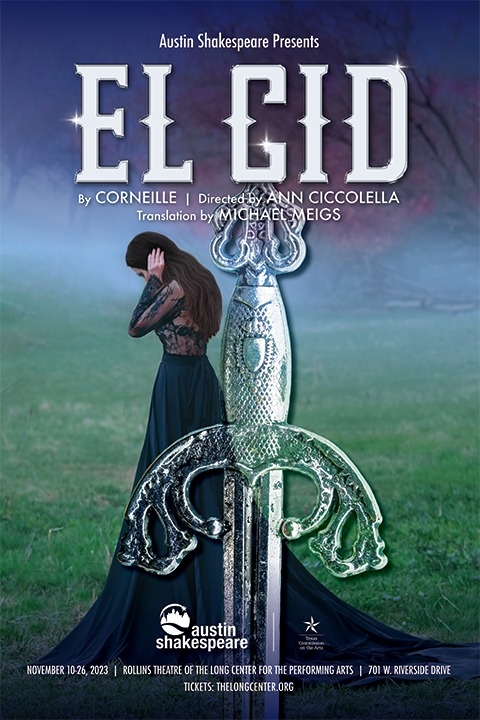Translator's Notes: Austin Shakespeare's EL CID by Pierre Corneille, November 10 - 26, 2023
by Michael Meigs
Ann Ciccolella’s mid-August email to me, a casual inquiry about a play script, was the beginning of a translation experience as unexpected as it was spellbinding.
Her plan was for Austin Shakespeare to produce a translation of Pierre Corneille’s classic romantic drama Le Cid, written in 1636, an oeuvre still held in such reverence by the French that it’s still taught to middle schoolers. Our daughter, obliged to study it at that age, was taken back: why were French schools teaching a highly mannered piece in rhyming Alexandrine couplets about the hero who reconquered Spain from the Arabic speakers who’d inhabited much of the Iberian peninsula for eight hundred years?

Thereby, of course, hangs a tale. Many, in fact. An anonymous poet produced El Cantar de Mio Cid (Epic of my Cid) in the twelfth century; around 1610, during Spain’s Golden Age of drama, Guillén de Castro y Mateo drew on that epic poem and other versions to write Las Moçedades de Rodrigo (The Youthful Exploits of Rodrigo). Some twenty-five years later the prodigiously productive French dramatist and versifier Pierre Corneille reworked his Spanish counterpart’s play into Le Cid.
Like many other Spanish terms, the word “Cid” comes from Arabic. “Sayyid” means “Lord” or “King.”
A 1961 Hollywood version of the saga starred Charlton Heston and Sophia Loren. Other than the protagonists’ names (Rodrigo and Ximena), that sprawling epic had almost nothing in common with Corneille’s telling.
The Cid’s mythic exploits are integral to the Spanish nation’s concept of its own history. Everybody needs a hero, especially one who succeeds in uniting the people and defeating the enemy (cf. George Washington).
I downloaded Corneille’s text and compared it with the script Ann had in hand. Detecting some clunky language and even some mistakes, I offered my own rendering of a couple of scenes in Act I. And with that, we were off to the races.
It might not have happened. I’d bid on translating a Swedish historical narrative. That job didn’t materialize. I was free to devote myself to creating an acting version which Ann decided title in Spanish: El Cid.
She wanted 10 to 15 percent of Austin Shakespeare’s El Cid to be in Spanish.
This was a deep dive. Corneille’s French is elaborate and poetical, almost acrobatic. His phrases and syntax do elaborate turns to deliver the whole play in rhyming couplets. Various translators into English have attempted the same; Ann comments that Richard Wilbur’s version is probably the best.
That was a mountain I wasn’t prepared to climb. Especially when I realized that this would be the first presentation of Austin Shakespeare’s 2023-2024 season, opening in November in the Rollins Theatre black box at the Long Center for the Performing Arts.
I had about five weeks to produce the full play script.

Themes
Corneille creates opposing dilemmas for his protagonists the young aristocrat Rodrigo and his lady love Ximena (“Chimène” in French). On one hand are the dictates of a rigid code of honor that required Spanish aristocrats to avenge an insult by killing the offender in trial of arms; on the other are the desires and dictates of romantic love. Rodrigo finds himself obliged to fight Ximena’s father, whom he kills in a duel; Ximena finds herself obliged to avenge her father’s death by insisting that Rodrigo be executed, although she still adores him. Her plight is encapsulated in her cry, “One half my heart the other half has slain!”
Le Cid is a wordy play, for Corneille repeatedly thrusts his protagonists into debate, his way of emphasizing the difficulty, perhaps the impossibility, of reconciling fundamentally opposed absolute principles. He portrays a similar conflict with the dilemma of the king’s only daughter, the princess whose royal blood obliges her to marry a royal husband although she’s deeply in love with the same knight, Rodrigo.
Noodling
Corneille’s elaborate, self-consciously elegant language was a challenge. Its style seemed inappropriate for a company reputed for its accomplished delivery of Shakespeare and works of modern English-language playwrights. I found myself looking deep into Corneille’s complex formulations in an effort to extract the playwright’s messages and the characters’ emotions. I put these into blank verse, a format more familiar both to English speakers and to actors practiced in English-language classic drama.
It occurred to me much later that groping into the depths of Corneille’s art resembled the American South’s technique of capturing catfish with one’s bare hands, known as “noodling.”
For example, here’s Ximena’s first appeal to the king for justice as she describes Rodrigo’s crime, in Corneille’s original text and my version:
|
Chimène Sire, mon père est mort ; mes yeux ont vu son sang |
Ximena Sire, my father is dead; and as he died |
|
Couler à gros bouillons de son généreux flanc ; |
I saw the blood pour from his noble side; |
|
Ce sang qui tant de fois garantit vos murailles, |
That blood which defended your walls, |
|
Ce sang qui tant de fois vous gagna des batailles, |
That blood which won your royal wars, |
|
Ce sang qui tout sorti fume encor de courroux |
That blood, which shed, still smokes in anger, |
|
De se voir répandu pour d’autres que pour vous, |
At being lost, not for you but at an assassin’s hand. |
|
Qu’au milieu des hasards n’osait verser la guerre, |
Rodrigo has stained the palace courtyard |
|
Rodrigue en votre cour vient d’en couvrir la terre. |
With the precious blood that war did not dare to shed . |
|
J’ai couru sur le lieu, sans force et sans couleur : |
I rushed to the place and found Father lying, |
|
Je l’ai trouvé sans vie. Excusez ma douleur, |
Drained of strength and color. Dead! |
|
Sire, la voix me manque à ce récit funeste ; |
|
|
Mes pleurs et mes soupirs vous diront mieux le reste. |
|
Corneille’s end rhymes are bolded above. Reworking his ideas into English phrasing and rhythm, I often found it possible to rhyme, though at times not at the ends of lines, and to use assonance (near rhymes, such as “walls” and “wars,” above).
The bilingual text
Ann’s request to craft from ten to fifteen percent of the text in Spanish posed a different challenge. Because many in the audience would not understand Spanish, it was vital to assure that ideas and emotions expressed in Spanish would be comprehensible to them. Much of the time I echoed or paraphrased the Spanish in adjacent lines in English (as one actor commented, “You often had two chances to get the meaning”). In other instances, such as Ximena’s Spanish-language plea to her black mourning garb to remind her of her duty to resist her affection for Rodrigo, gesture and movement conveyed the significance of a declamation in a foreign language.
In the earliest scenes translated, I moved entire texts into English but took the liberty of omitting some thoughts (as in the example above, where I dropped Ximena’s last two lines in French — her plaint (“Forgive my distress, /Sire, my voice fails, telling this terrible tale;/ My tears and sighs will better tell you the rest”) seemed superfluous. (But note: this quick translation, just made, appeared with the acceptable rhyme between “distress” and “rest”!).
In other passages, more extensive curtailing was possible. My estimate is that Austin Shakespeare’s script of El Cid, which took a scant two hours of stage time even with restatements in Spanish, may be as much as an hour shorter than Le Cid.
By actual count, the Spanish words are sixteen percent of the play script.
About halfway through the translation I began using both English and Spanish in my first draft. I patterned Spanish verse and vocabulary upon Golden Age dramas I studied as an earnest undergraduate half a century ago. The Spanish-language texts, especially the lengthier ones, are crafted in relatively high tone and register, in some cases employing antiquated language and syntax (e.g., “más es menester” instead of “es más importante”). At the second Saturday’s post-performance Q and A, Austin choreographer Toni Bravo praised the Spanish verse. That brought me great satisfaction, for I was aware that even among the Spanish-heritage audience members, few would be familiar with the conventions and locutions of the Golden Age.

Familiar address
Corneille’s characters use familiar address (“tu”) when speaking to equals and formal address when speaking to the king. I chose to use formal address in Spanish throughout the script, except in specific circumstances:
- Don DIego, Rodrigo’s father, addresses his son as “tu,” while Rodrigo uses “Usted” to express respect for his father.
- When challenging Count Gormaz, Ximena’s father, to the duel that drives the plot, Rodrigo expresses contempt for his foe by using familiar address; Gormaz initially responds with formal address but once he recognizes Rodrigo’s audacity, similar to his own when young, Gormaz switches to familiar address.
- Protagonists Rodrigo and Ximena initially address one formally, including when he appears unexpectedly in her house of mourning to beg her to take his life. Their exchanges are intense. An emotional turning point occurs when she refuses and then pleads with him to leave to avoid public scandal. She bursts out, “¡Sal de aquí!” From that point on, despite their conflict and imposed enmity, they consistently use familiar address.
L’Envoi/Despedida/A Final Word
I began study of Spanish as a high school sophomore, about the same time that I discovered theatre as an art and Shakespeare as a playwright and poet. At university I majored in Spanish literature, although three years of intense engagement with the university theatre powerfully tempted me to major in drama.
Languages, literature, and theatre have always engaged me. After a diplomatic career and post-retirement relocation to Austin, I returned to those origins by reviewing theatre and doing literary translations.
A literary translator works sequentially, moving ideas from one language to another, then revising the new version, often several times. In the process, those words become the translator’s own. This is a magic process, a spell cast both upon the words and upon the translator.
Ann Ciccolella’s audacious project to have Austin’s prestigious Shakespeare company do Corneille’s Le Cid was a complete surprise to me, an opportunity that seemed to fall out of the sky. It’s impossible to convey the thrills I’ve felt as watching her, the cast, and the crew bring this translation to life. These talented artists are devoted to creative interpretation.
And as I sat in the audience, my familiar haunt from fifteen years of reviewing theatre, I was enchanted, for I knew exactly which words in English blank verse and classic Spanish were about to come out of their mouths. I was deeply immersed in the characters, hypnotized by their conflicts . . . and immensely grateful that Ann Ciccolella consulted me and was willing to encourage me to undertake this project.
El Cid
by Pierre Corneille, translated and adapted by Michael Meigs
Austin Shakespeare
November 10 - November 26, 2023
NOVEMBER 10 - 26, 2023
THE ROLLINS THEATER AT THE LONG CENTER FOR THE PERFORMING ARTS
Tickets, which start at $20, are available here.
For student discounts with valid ID (less than $20) or discounts Group discounts for 10 or more people, please call the Long Center's 3M Box Office at: 512.474.LONG (5664) (M-F 10am-5pm CT) or email boxoffice@thelongcenter.org.
